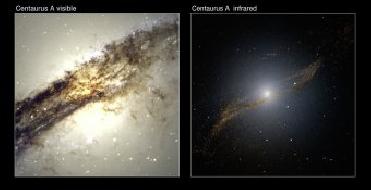
A visible-light image (left) and a near-infared view (right) of Centaurus A giant galaxy. Image credit: ESO
PARIS (BNS): A giant elliptical galaxy, waiting to gulp down the last remnants of its prey � a small spiral galaxy � has been captured in an unprecedented detail by ESO�s New Technology Telescope.
The �cannibal� galaxy Centaurus A, located at a distance of about 11 million light-years in the southern sky, is the nearest giant, elliptical galaxy. Its mass is about 200 million times the mass of our Sun, or 50 times more massive than the one that lies at the centre of our Milky Way.
The supermassive black hole in Centaurus A is continuously fed by material falling onto into it, making the giant galaxy a very active one.
Between 200 and 700 million years ago, the galaxy is indeed believed to have consumed a smaller spiral, gas-rich galaxy � the contents of which appear to be churning inside Centaurus A's core, likely triggering new generations of stars.
Images obtained by ESO�s telescope show thousands of star clusters, strewn like glittering gems, churning inside Centaurus A. It also reveals the �twisted and wrapped last meal� of the giant galaxy.
What astronomers have found in these images is surprising. �There is a clear ring of stars and clusters hidden behind the dust lanes, and our images provide an unprecedentedly detailed view toward it,� said Jouni Kainulainen, lead author of the paper reporting the new results.
�Further analysis of this structure will provide important clues on how the merging process occurred and what has been the role of star formation during it,� the researcher said.
First glimpses of the �leftovers� of Centaurus A�s �meal� were obtained by ESA�s Infrared Space Observatory, which showed a 16,500 light-year-wide structure, very similar to that of a small barred galaxy.
More recently, NASA�s Spitzer Space Telescope resolved this structure into a parallelogram, which can be explained as the remnant of a gas-rich spiral galaxy falling into an elliptical galaxy and becoming twisted and warped in the process. Galaxy merging is the most common mechanism to explain the formation of such giant elliptical galaxies.
 Previous Article
Previous Article












The Indian Air Force, in its flight trials evaluation report submitted before the Defence Ministry l..
view articleAn insight into the Medium Multi-Role Combat Aircraft competition...
view articleSky enthusiasts can now spot the International Space Station (ISS) commanded by Indian-American astr..
view article